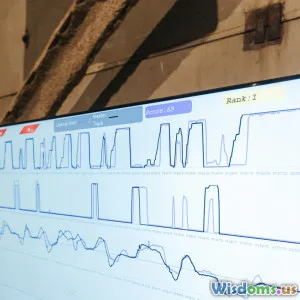
Hierarchical Regression Analysis Explained with Real World Examples
20 min read Discover hierarchical regression analysis with practical, real-world examples, demystifying its process and applications in research and analytics. (0 Reviews)
Hierarchical Regression Analysis Explained with Real World Examples
Unlocking the true value of data often means delving deeper than surface relationships. When multiple factors interact in complex ways, simple regression models may not capture the full story. This is where hierarchical regression analysis comes in—a statistical tool that helps researchers dissect the layers of influence in their data. Whether you're evaluating the impact of education on salary or the effectiveness of a new intervention in healthcare, understanding hierarchical regression can elevate your analytical approach.
What is Hierarchical Regression Analysis?

Hierarchical regression analysis is an extension of ordinary least squares (OLS) multiple regression. It involves entering independent variables (predictors) into the regression model in steps or "blocks." This sequence reflects theoretical reasoning or practical priorities about which variables to control for—and which to evaluate for added impact.
The rationale is to first control for known predictors (such as demographic factors) and then examine the additional contribution of variables of interest. This is particularly useful for:
- Dissecting out the unique influence of specific predictors
- Controlling confounding factors
- Quantifying the incremental improvement in explained variance (R²)
Example: Imagine investigating what affects students' grade performance. Common knowledge says prior academic achievement and parental education matter. Later, you might want to test if participation in a summer math camp adds further predictive power—even after accounting for those baseline factors.
In short: Hierarchical regression lets you answer nuanced questions like: "How much extra does this new variable help explain variation, beyond what we already know?"
When Should You Use Hierarchical Regression?

Not every regression problem benefits from a hierarchical approach. You should consider it when:
- Theory Guides the Analysis: You have theoretical reason to enter variables in a certain order, such as entering background variables before new predictors.
- Multiple Blocks of Variables: You have conceptually distinct sets of variables (e.g., demographics, behaviors, interventions).
- Want to Test Incremental Value: You aim to demonstrate how much an intervention or process improves prediction after controlling for other known factors.
- Policy or Resource Decisions: You need to show the added benefit of additional interventions for stakeholders.
Healthcare Example: A hospital administrator wants to test if a new digital health app improves patient follow-up compliance. Block 1 includes age, gender, and comorbidities; Block 2 adds app usage. Hierarchical regression can show how much improvement in compliance is explained by the digital app, above and beyond background characteristics.
Tip: Hierarchical regression is valuable in published research because it demonstrates methodological rigor—the analysis shows not just what is significant, but the incremental value of each step.
Building Blocks: How to Structure a Hierarchical Regression

The process unfolds as a series of clearly defined steps:
Step 1: Select and Justify Your Blocks
Break your predictors into meaningful blocks:
- First Block: Control variables—demographics, pre-intervention features, baseline measurements.
- Second Block(s): Variables your research hypothesis focuses on (e.g., new interventions, psychological measures, or risk factors).
Case Example:
- Study Topic: Predicting job performance among new hires.
- Block 1: Basic controls (education level, years of experience)
- Block 2: Personality traits (assessed by a standardized inventory)
Step 2: Enter Blocks Sequentially in the Model
Enter Block 1 and run the regression. Note the R² value (variance explained). Next, enter Block 2, then observe how much R² increases. This change (ΔR²) reveals how much extra explanatory power Block 2 adds.
Key metric:
- ΔR² (Delta-R Squared): The increase in explained variance after adding a block
Step 3: Interpret Changes with Caution
Analyze whether the newly added predictors are statistically significant and whether the ΔR² is meaningful. Even small changes might matter in large datasets or when the addition represents an impactful intervention.
Pro Tip: Use F-tests to assess whether ΔR² is statistically significant.
Hierarchical vs. Standard Multiple Regression

It’s a common misconception that hierarchical regression is just a more complicated way to do multiple regression. Here’s how they differ:
| Feature | Standard Multiple Regression | Hierarchical Regression |
|---|---|---|
| Order of Entry | All predictors entered simultaneously | Predictors entered in steps (blocks) |
| Analysis Objective | Examine total effect of all predictors | Assess incremental validity of new predictors |
| Research Design | When all predictors are equally important | When theory or previous findings suggest order matters |
| Typical Use Case | Predict outcome from a mix of variables | Test whether intervention adds predictive power |
| Reporting | Single R² value | Sequence of R² and ΔR² values, block-wise interpretations |
Standard multiple regression tells you the overall story. Hierarchical regression tells you the sequence of impact—crucial in program evaluation, medical trials, or when convincing decision-makers of the unique value added by an innovation.
Real World Example 1: Education Policy and Student Achievement

Suppose an urban school district wants to know how much after-school tutoring improves student test scores over one academic year.
Research Question: Do after-school tutoring programs contribute significantly to student achievement above and beyond family and school-level influences?
Hierarchical Regression Approach:
Block 1: Control Variables
- Socioeconomic status (SES)
- Parental education level
- Prior year's achievement score
Block 2: School Characteristics
- Average expenditure per student
- Teacher-student ratio
Block 3: After-school Tutoring Participation
- Participation in tutoring program (yes/no)
- Enter Block 1: These factors typically explain a substantial share of variance in student performance.
- Enter Block 2: School resource factors are added to see their incremental value.
- Enter Block 3: Only now do we introduce the tutoring variable. The key is to see if tutoring still matters—after all other known influences are accounted for.
Findings:
- Block 1 (SES, parental ed, prior score): R² = 0.45
- Block 2 (school resources) adds: ΔR² = 0.05 (Total R² = 0.50)
- Block 3 (tutoring): ΔR² = 0.08 (Total R² = 0.58)
Interpretation: The after-school tutoring program explained an additional 8% of variance in test scores—after considering socioeconomic, family, and school background—indicating a substantial and unique contribution.
Policy Value: This approach persuades funding bodies and schools that beyond addressing equity through resources, targeted interventions like tutoring can provide additional, measurable benefits.
Real World Example 2: Predicting Employee Turnover in Organizations

Employee turnover is a costly challenge in many organizations. Suppose an HR analyst wants to predict who’s most likely to leave in the next year, and whether a new workplace wellness initiative reduces this risk.
Hierarchical strategy:
Block 1: Demographics
- Age
- Time at company
- Department
Block 2: Job Satisfaction Factors
- Satisfaction survey score
- Average overtime hours per week
- Supervisor support level
Block 3: Participation in Wellness Program
- Enrolled in program (yes/no)
Application:
- First, base characteristics and job stressors are entered.
- Only last do we add the variable for wellness program participation.
Results might show:
- Demographic and job factors account for most variance, but wellness program enrollment adds a small but significant reduction in turnover probability (ΔR² = 0.03, or 3%).
Actionable Advice: Even modest ΔR² can have large practical implications when applied to workforce management—especially for interventions that are cost-effective and scalable, such as wellness programs.
Real World Example 3: Healthcare Outcomes and Lifestyle Interventions

A research group evaluates whether a structured exercise program improves recovery outcomes after cardiac surgery.
Scenario:
Block 1: Patient Background
- Age
- Sex
- Severity of heart disease
Block 2: Clinical Variables
- Type of surgery
- Length of hospital stay
- Medication regimen
Block 3: Participation in Exercise Program
- Yes/No (post-discharge rehabilitation program)
Interpretation Focus:
- If, after accounting for background and clinical variables, participation in the exercise program is still a significant predictor—accounting for, say, 7% more explained variance in the recovery score—this supports policy investments in post-discharge services.
Professional Insight: Often, individual-level or programmatic interventions come under scrutiny to justify their added value relative to established predictors. Hierarchical regression provides the statistical clarity to support such decisions.
Best Practices for Performing Hierarchical Regression

There are common pitfalls and proven tips:
- Justify Block Order: Avoid arbitrary sequencing. Use theoretical rationale, research precedent, or stakeholder input.
- Check for Multicollinearity: Strong correlations within blocks can distort results. Assess Variance Inflation Factor (VIF) for predictors at each step.
- Interpret ΔR² with Context: A small incremental R² can be practically meaningful, especially in large samples or costly outcomes.
- Report Standardized Coefficients: These display relative effect sizes—important for comparison within and across blocks.
- Transparency in Reporting: Disclose the variable entry order and rationale in publications or presentations.
- Validate with Independent Samples: If possible, replicate the hierarchical analysis with validation datasets to check for consistency.
- Sensitivity Analysis: Explore if results hold under different block orders where theoretically justifiable, emphasizing robustness.
Pro Tip: Use specialized software (e.g., SPSS's Blockwise entry, R's
lm()with stepwise modeling) to facilitate hierarchical entry and reporting.
Common Pitfalls and How to Avoid Them

- Ignoring Theoretical Order: Flipping the block order can yield misleading results, inflating or deflating the effects of predictors.
- Underestimating Collinearity: Especially if new blocks are correlated with earlier controls, interpret ΔR² and coefficients with caution.
- Overfitting: Adding too many variables can produce models that fit the current data but generalize poorly to other contexts.
- Misreporting Results: Present ΔR² and coefficients for each block—omitting this sequence loses the hierarchical value.
Best Practice: Always pre-specify your block order and variable list in your analysis plan.
Beyond R-Squared: Interpreting the Full Picture

While ΔR² illustrates the added variance explained, it’s equally important to consider:
- Significance of Coefficients: Does the new variable independently predict the outcome, after controlling for earlier blocks?
- Effect Size and Practical Relevance: Is the increment meaningful for policy or decision-making? Even a small boost in variance explained can justify funding or rollout.
- Confidence Intervals: These provide a range of plausible values, aiding decision-makers in risk assessment.
Visualization Tip: Use bar charts or regression summary plots to show how much each block boosts R².
Frequently Asked Questions

Q: Does hierarchical regression require large sample sizes?
- Larger samples enhance statistical power, especially for detecting small incremental changes. But even in moderately sized datasets, hierarchical analysis clarifies each variable set's role.
Q: Can I use hierarchical regression for logistic (categorical outcome) models?
- Yes! Hierarchical logistic regression handles binary outcomes (like yes/no, recovered/not recovered) by adding variables in blocks, using the equivalent increment in model fit (pseudo-R², log-likelihood change).
Q: Are stepwise regression and hierarchical regression the same?
- No. Stepwise regression enters/removes predictors based on statistical algorithms, potentially ignoring theoretical rationale. Hierarchical regression enters blocks based on research design or prior evidence, aligning with theoretical and practical considerations.
Final Thoughts: Making the Most of Hierarchical Regression

Hierarchical regression isn’t just for academics or data scientists—it’s a versatile technique for anyone looking to make smarter, evidence-based decisions when multiple factors are at play. By structuring the order of entry, you can untangle the impact of new interventions, clarify policy questions, and build clarity in complex analytic settings.
The art and science of this method lies in thoughtful block definition, rigorous execution, and transparent communication. When used skillfully, hierarchical regression opens a window into the layered realities shaping outcomes—armed with both the nuance of incremental insight and the power to drive actionable change.
Rate the Post
User Reviews
Popular Posts



















